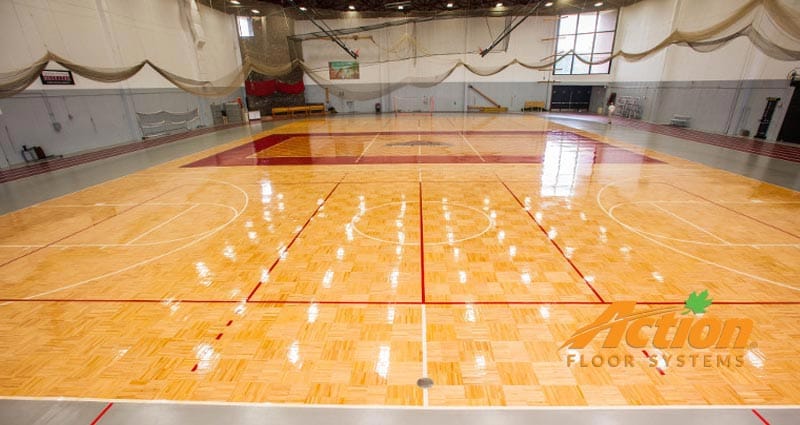
Up in the Northwoods of Wisconsin, we know a few things about winter. It can be beautiful, but it’s also a brutal season.
Snow and ice, road salt, extreme temperatures, and dry air have the potential to have a negative effect on hardwood maple sports flooring. Once you’ve invested in a quality court for your gymnasium, you’ll want to protect it.
That’s why we’ve put together this advice to help you keep your court looking like new no matter what Old Man Winter has in store.
- The Problem: People are tracking in snow and salt into your gym.
- The Solution: Use floor mats and make rules about street shoes on the court.
Shoes and boots covered in snow, sidewalk salt, and slush from outdoors can make your gym a mess. Worse yet, if moisture is left on your hardwood court, it could cause damage.
There should be door mats at all entrances to the building and more at the entrance to the gym so people can wipe their feet and stomp off excess snow. Athletic Business specifically suggests scraper mats so people can remove debris like salt from the soles of shoes.
Winter-related damage is also an excellent reason to have a rule about only using clean footwear on the playing surface. Consider posting a sign reading “No Street Shoes Allowed on the Court” to remind people.
- The Problem: Dry winter air is causing damage to sports flooring.
- The Solution: Monitor and control the indoor climate of your gymnasium.
Even though your gymnasium is indoors it can still be affected by the harsh cold and low humidity of winter. These conditions can cause hardwood sports flooring to shrink and crack.
You’ll want to keep an eye on the climate of your building during colder months and do what you can to keep the conditions optimal.
Writing for CampusRecMag.com, Executive Director Daniel Heney of the Maple Flooring Manufacturer’s Association (MFMA) recommends humidity levels between 35% and 50% and an indoor air temperature between 55° and 75° Fahrenheit no matter what time of year it is.
You may notice some minor gaps between planks in your sports flooring during the fluctuating conditions of winter. While that may be unavoidable, maintaining a consistent indoor environment is still important. Heney notes that “shrinkage and/or expansion may occur with relative humidity variation in excess of 15%.”
- The Problem: Winter finds its way inside the building.
- The Solution: Make sure your entire facility is ready for the season.
During extreme winter conditions, the rough weather may find its way inside your gym. That’s what happened at a high school in Maryland when a blizzard led to leaks in the gymnasium roof, which caused major damage to the floor.
They tried to dry out the wood and restore the floor, but in the end, large areas of the court needed to be replaced and the entire gymnasium floor needed to be sanded and refinished.
Frozen pipes that burst are yet another potential hazard to gym floors. That’s why you should consider preparing every part of your building for winter.
If there are exterior doors connected to the gym, they should be properly weatherproofed to keep moisture and cold air outside. Check your gym’s roof for signs of leaking before the next big storm hits. Pipes should be insulated and nighttime temperatures in the building should be warm enough to prevent pipes from freezing.
- The Problem: Increased activity during the winter leaves floors scuffed and dirty.
- The Solution: Set a regular cleaning schedule for maintenance staff.
During the winter, high school and college basketball will be in full swing. Plus, your gym may also be used for dances, concerts, pep rallies and other events. All that activity can take a toll and often leave a mess behind.
To keep up appearances while avoiding damage, organize regularly scheduled cleaning of your hardwood maple sports flooring.
Dust and dirt can act like sandpaper on your hardwood court, leaving scratches behind, which is why you should frequently dust mop and damp mop the floors. Don’t forget, moisture is an enemy of hardwood. That’s why Athletic Business magazine recommends wringing the mop out as much as possible and using a towel to dry off streaks of wetness.
Any spills on your gym floor should be wiped up immediately. Clean and vacuum the floor mats otherwise they’ll build up too much debris and people will track it into the gym. If you use cleaning chemicals, make sure they are products approved by the flooring manufacturer.
Protect Your Sports Flooring with Action AirRide®
Another important step towards guarding your hardwood court is the use of a gymnasium floor cover system. These covers are especially useful for multi-use gyms and can protect the hardwood court during non-sports events like science fairs, when things can get messy, or school dances to avoid scuffing.
Action Floor Systems® provides the advanced Action AirRide® system for the best protection you can get. We engineered this floor cover system with a patented air blower and roll out mechanism to make setup and removal easy and safe. It’s simple enough for two people to get the job done.
Learn more when you watch the video on Action AirRide below. Contact us today! Call Action Floors with any questions you have about this product, our hardwood floor systems, or synthetic sports flooring options at 800-746-3512.


















